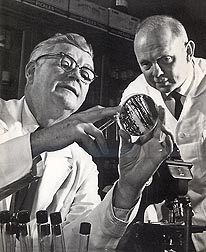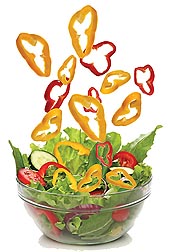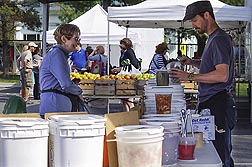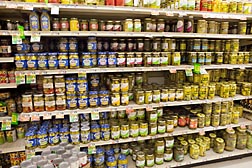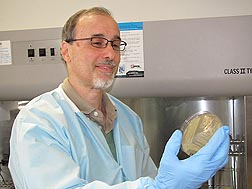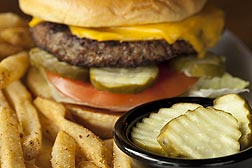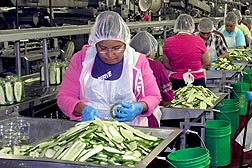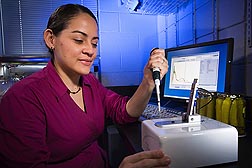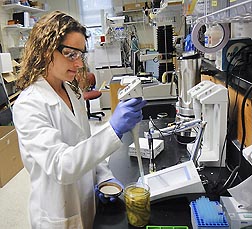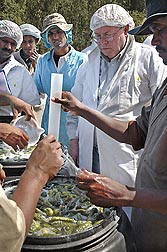A Lab That Keeps Us All Out of a Pickle
George Washington had a collection of 476 kinds of pickles. To prevent scurvy, Christopher Columbus stocked pickles on the Niña, Pinta, and Santa Maria. Julius Caesar, believing pickles to be invigorating, added them to the Roman legions’ diet. In 5000 BCE, the Babylonians were known for pickling with date palm vinegar. Pickling—storing food in a salty brine or an acid solution, usually vinegar (acetic acid)—is one of humankind’s oldest ways of preserving foods.
Pickles have always been popular in the United States. Today, they are having a widespread renaissance, powered in part by trendy interest in craft brands that are showing up in local stores and farmers markets all over the country. Today, each American eats an average of 9 pounds of pickles a year.
While pickling was recognized as a safe food-preservation method long before the discovery of bacteria, the kind of data that today’s precise food safety standards require was not established until relatively recently.
|
|
By the mid-1990s, there had not been a foodborne-illness outbreak traced to commercial pickle production in 50 years, and the basic practices that producers were following had long been considered acceptable. But in the late 1990s, incidents of bacterial contamination in acidic foods like unpasteurized orange juice and apple cider, which are the same pH as pickles, led to some sickness and even deaths. The incidents alerted the U.S. Food and Drug Administration (FDA) that pathogens such as Salmonella and Escherichia coli O157:H7 survived at more acidic pH levels in juices than previously believed, and this led to new juice regulations. It also raised collateral questions about these pathogens in acidified foods such as pickles. This resulted in closer scrutiny of acidified food processes and prompted FDA to issue draft guidance applicable to the pickle industry.
“In the 1970s, when acidified food regulations were promulgated, the state of the science for microbial hazards in acid and acidified foods was not as well understood as it is today,” explains Don Zink, senior science advisor at FDA’s Center for Food Safety and Applied Nutrition. “It was ti
me for the regulations and industry guidance to catch up with the science of today.”
The concern, unlike in the 1970s when botulism was the primary worry, was making certain that E. coli O157:H7, Salmonella, and Listeria cannot survive the pickle-making process to cause illness. FDA has generally regarded a 99.999 percent, or 5 log, reduction in the bacterial pathogen population (which means cutting the number of bacteria present by 100,000 fold) to be sufficient to lower the public health risk to a negligible level.
Changes in the pickle industry also contributed to the need for better scientific understanding. For example, cold-packed pickles have become popular in recent years, and the processes for making them are very different from those for traditional pickling. But no one knew for certain precisely how long pickled vegetables need to spend at what concentration of acid and at what temperature to achieve the desired 5 log reduction, Zink points out.
|
|
Supplying Scientific Precision
That’s where the Agricultural Research Service came in. The agency’s Food Science Research Unit, in Raleigh, North Carolina, is the only national laboratory that works full time on the processing of commercial pickled vegetables. Areas of research include food safety, microbiology, chemistry, food technology, and methodology.
With significant support and funding from the pickle industry, unit microbiologist Frederick Breidt and his team investigated how to consistently reach the 5 log reduction requirement and how to do it without harming the quality of the pickle products.
“The first ones we worked on were the simplest: the pasteurized pickles—dill, bread and butter, sweet, sour, gherkin, kosher—the ones that pretty much dominate the grocery store aisles,” explains Breidt. “What we found was that it took less than 1.2 minutes at 160°F (71°C) in a brine at pH 4.1 to get a 5 log reduction.”
Commercial pickle producers were already exceeding this, using 165°F (74°C) for 15 minutes as a standard for pasteurization, to inactivate enzymes and microbes that could harm product quality or cause spoilage.
“But now there is peer-reviewed, published science that proves, rather than assumes, that the industry meets FDA’s 5 log food safety standard,” Breidt says.
|
|
Then Breidt moved on to the acidified, shelf-stable, pickled vegetables, like peppers and okra, which do not undergo pasteurization because they would fall apart in the heat. These products are instead made safe through the combined bacteria-killing effects of low pH and high organic acid concentration, factors that are independent but related.
While the twin bactericidal effects had been previously known, no one had been sure which was more important to food safety or how to separate the impacts. Breidt started unraveling the science of how the pickling process provides food safety.
“We began to investigate what it was in the pickling process—the acid itself or the low pH—that kills E. coli more effectively,” Breidt says. “In our experiments with fermented products, we found that pH was more significant than acid concentration in affecting E. coli survival.”
Acid also kills bacteria more effectively at higher temperatures. What Breidt found was that at 50°F, pickled vegetables in jars need to be held for at least 6 days in vinegar at a pH of 3.3 or below to reach the 5 log reduction. But at 77°F, the jars only need to be held for 2 days at the same pH. Pickle products that are classified as “refrigerated style” need to be kept below 50°F. They are governed by a different class of regulations, so time and temperature data was not needed for them.
One thing that surprised Breidt was that certain strains of E. coli are the toughest of the foodborne pathogens for most acidified products. “I thought we would have to be most on the watch for Salmonella survival. But we found that E. coli can survive harsher acid conditions for longer, so we always used E. coli strains in our testing.”
Finally, there were the iconic sliced dill chips for hamburgers, which come in institutional-sized containers. These pickles are fermented rather than pasteurized, mainly because those containers would hold too much heat, and the pickles would “cook” beyond acceptability. However, Breidt found that the fermentation process itself is sufficient to ensure food safety.
|
|
Applying the Lab Work
Zink, who has been involved in both the introduction of FDA’s new 5 log reduction requirement and formulating guidance for how to implement it, extolls all the “extra” steps Breidt has taken, saying, “That’s what is so important about what Breidt and this lab do. Both FDA and industry can depend on the objective data, the basic science, and his depth of knowledge and expertise so that both sides understand how to reach the goal of great pickles with great assurance of food safety.
“There are not many instances where we have scientists working that closely with both industry and regulators. It’s a very good model that promotes a level of cooperation that I wish we would see more often,” he adds.
Brian Bursiek, executive vice president of Pickle Packers International, the principal industry association, echoes Zink’s praise for the ARS Food Science Research Unit. “Because the staff in Raleigh are intimately familiar with pickling production processes and FDA requirements and procedures, they can help clarify what changes actually mean and require,” Bursiek says. “They are helpful in educating industry about how to comply. The lab provided science-based solutions when the industry and FDA needed them.”
|
|
The respect that the lab’s work engenders also supports FDA in other crucial ways. For example, having Breidt’s precise data on what conditions achieve a 5 log reduction, an FDA inspector at the U.S. border was well armed while checking a large, very expensive shipment of olives coming from Italy. The inspector found the pH of the solution that bathed the olives to be much higher than what Breidt had reported as effectively safe.
“Given the six-figure value of that shipment, we actually called Fred to double check that the pH was out of the safe range, and then we rejected it for import,” Zink says. “Because of this lab’s work, there was definitive, objective science on which we based our decision. The import company didn’t even go to court to try and fight the FDA ruling in the face of such respected science.”
That wasn’t the first time the ARS Food Science Research Unit’s work has been of specific use to FDA, according to Zink. “Once in a while, when state or FDA inspectors see a pickle production operation for the first time, they are surprised to see large, 10,000-gallon vats open to the sky. They get a little excited and want lids added or suggest that the vats should be made of stainless steel,” he recounts. “I always pull out an old journal paper proving that it is the ultraviolet light from the sun that is the sanitizing agent for those vats of cucumbers, that the sunlight prevents mold growth, so they need to be open to the sky and sun. The author of that paper was John L. Etchells, the first research leader of the ARS lab.”
That work is just part of a long history of contributions from the ARS Food Science Research Unit.
A Lab With History
Etchells, who led the lab from 1937, shortly after it was formally organized, until he retired in 1975, made many contributions to the science of safe and efficient commercial pickling. But perhaps his greatest contribution was developing the first commercial pasteurization process for grocery store shelf-stable pickles. He also improved the fermentation process and reduced spoilage by a significant amount, which helped make pickles less expensive and increased their consumption in the United States. For example, dill pickle slices became a standard accompaniment on hamburgers in restaurants everywhere, and today, they represent 25 percent of the pickle market.
So highly regarded have his processes been for providing food safety that, in the mid-1990s, they got a pickle supplier off the hook for a food recall when a fast-food chain tried to blame the hamburger pickle as a source of staphylococcal enterotoxin, which would have required a large-scale product recall. The ARS lab tested the supplier’s pickle slices for FDA and found that they were indeed clean. Other studies by the lab showed that the positive enterotoxin test was a false positive, caused by natural peroxidase enzymes that formed during the fermentation process. This was accepted as confirmation that the pickles did not contain any enterotoxin.
Etchells also worked out the first preservation prediction chart in the 1950s for sweet pickles that were not pasteurized by heat. It gave an acid/sugar/salt combination for commercial production, ensuring pickles that would be stable during shelf storage.
“This chart is still used as an industry standard,” says Carl Gilbert, product planning and scheduling manager for B&G Foods, North America, Inc., in Hurlock, Maryland. “It is still our benchmark. For example, when we are developing a new relish product that is going to be made from fermented pickled vegetables and not thermal-processed (pasteurized), we go back to that chart to be sure we are on the correct side of food safety. If we didn’t follow this chart and then had to do a full pasteurization, it would really affect the flavor and texture of the product.”
|
|
More Advances
Important advances continued to flow from the lab after Henry Fleming followed Etchells as research leader from 1977 until 2003. Foremost among these was finding the cause of “bloating”—pockets of gas that balloon up within cucumbers during fermentation—which disqualified as much as one-third of each standard 10,000-gallon production batch from its highest value use as whole pickles. Reducing bloat was an economic revolution for the industry.
Fleming, along with his successor, ARS chemist Roger F. McFeeters, who was research leader from 2003 to 2011, began working on the pickling industry’s major environmental problem—disposing of large amounts of brining salt. Brine disposal was one of the factors that helped push California olive pickling and processing out of that state and overseas in the 1980s. Environmental regulations have only continued to tighten since then.
Fleming’s and McFeeters’s work, which increased brine recycling many fold, is considered the lab’s third great revolution, this time both economic and environmental, for the pickling industry.
Today, ARS microbiologist Ilenys Pérez-Díaz and ARS food technologist Suzanne Johanningsmeier are continuing McFeeters’s work by replacing brining salt—sodium chloride—with calcium chloride. When it comes to environmental disposal, calcium chloride can be a desirable soil amendment rather than a pollutant.
“Roger McFeeters came up with the idea that sodium chloride could be substituted by calcium chloride to maintain firmness,” recounts Pérez-Díaz. “In laboratory studies, we found that it retains firmness in the cucumbers and even speeds up the microbiological work of fermentation. The problem is that in the absence of salt, it also speeds up the microbial activity of spoilage bacteria.”
To remedy that, the team tested adding sodium benzoate, fumaric acid, and horseradish extract, which is known to have antifungal properties.
“Our team finally came up with a technology that looked workable and reduced the amount of sodium chloride that would need to be disposed of by up to 80 percent,” Pérez-Díaz says.
Then they turned to nearby Mt. Olive Pickle Company, the largest independent pickle company in the United States, to try out the technology under commercial conditions. Mt. Olive technical services director Janet Turner says, “We were interested in the ideas because we want to show continued efforts to reduce chloride usage in our processes.”
The company started out experimenting with calcium chloride fermentation in eight 55-gallon barrels in 2010. By 2013, Mt. Olive was using the technology in 80 tanks, turning about 66,000 bushels of calcium chloride-fermented cucumbers into hamburger dill chips and several flavors of pickle relishes and salad cubes.
“Working with ARS researchers gave us access to knowledge and lab analyses in the beginning that would have been difficult for our company to obtain on our own,” Turner says. “The time and experience of Drs. McFeeters, Pérez-Díaz, and Johanningsmeier and their support staff gave us the confidence to conduct these trials.”
Now Pérez-Díaz and Johanningsmeier are working on applying the calcium chloride technology to gherkin pickles that are imported from India. They undergo a 40-day Atlantic transit time packed in vinegar, salt, and sulfite, which is now being considered as an undesirable ingredient for people who are sensitive to it.
“We are designing a system in small jars, reducing the salt and replacing it with calcium chloride and replacing the sulfite with fumaric acid and other natural preservatives. Right now, we are testing at the 40-liter semi-commercial scale,” says Pérez-Díaz.
The United States is a major gherkin market, but India also supplies them to many other countries, so improving the health and environmental circumstances of this product could have worldwide impact.—By J. Kim Kaplan, Agricultural Research Service Information Staff.
This research is part of Food Safety (#108) and Quality and Utilization of Agricultural Products (#306), two ARS national program described at www.nps.ars.usda.gov.
To reach scientists mentioned in this article, contact Kim Kaplan, USDA-ARS Information Staff, 5601 Sunnyside Ave., Beltsville, MD 20705-5128; (301) 504-1637.
"A Lab That Keeps Us All Out of a Pickle" was published in the July 2014 issue of Agricultural Research magazine.







